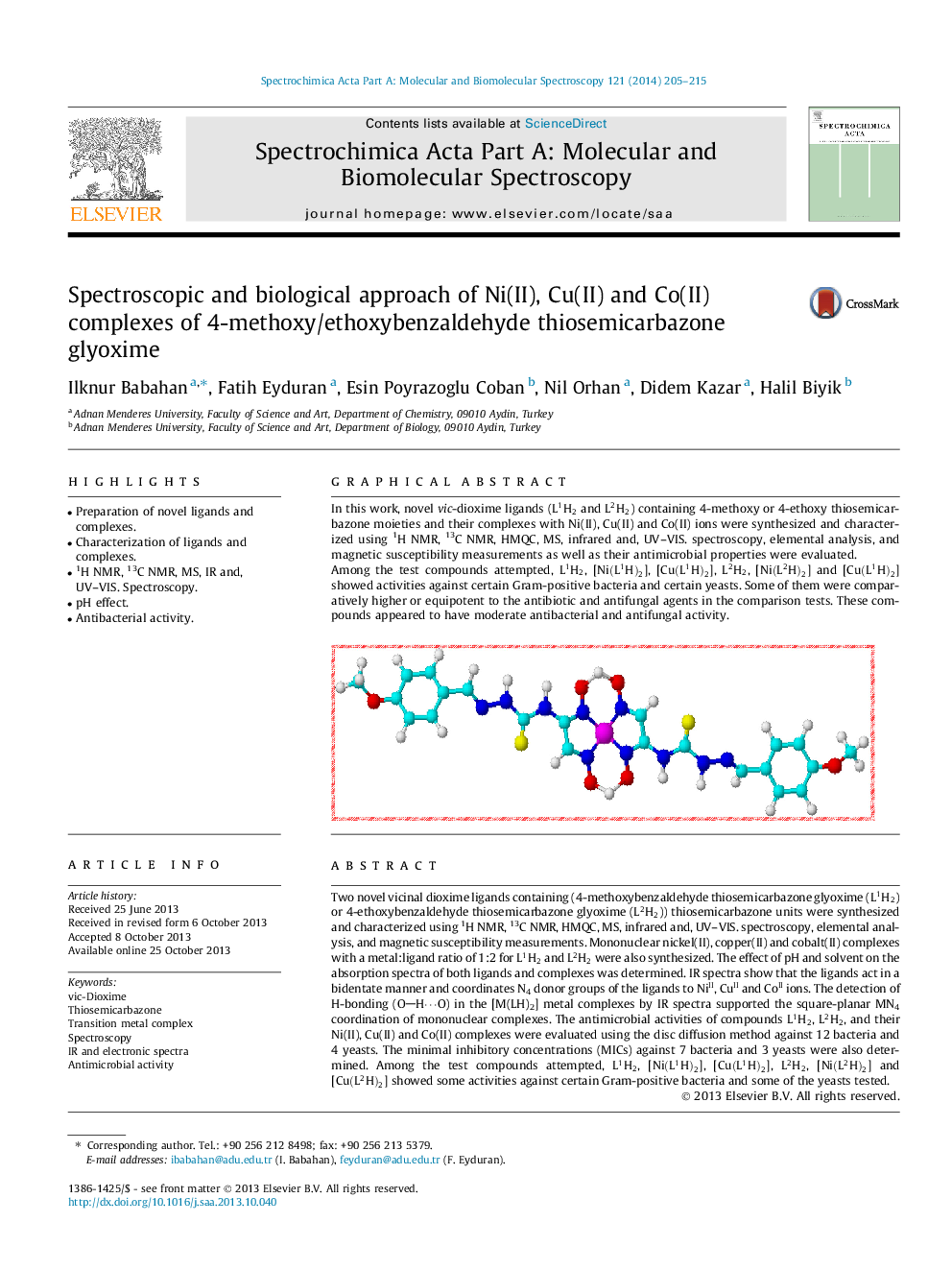| Article ID | Journal | Published Year | Pages | File Type |
|---|---|---|---|---|
| 1230465 | Spectrochimica Acta Part A: Molecular and Biomolecular Spectroscopy | 2014 | 11 Pages |
•Preparation of novel ligands and complexes.•Characterization of ligands and complexes.•1H NMR, 13C NMR, MS, IR and, UV–VIS. Spectroscopy.•pH effect.•Antibacterial activity.
Two novel vicinal dioxime ligands containing (4-methoxybenzaldehyde thiosemicarbazone glyoxime (L1H2L1H2) or 4-ethoxybenzaldehyde thiosemicarbazone glyoxime (L2H2L2H2)) thiosemicarbazone units were synthesized and characterized using 1H NMR, 13C NMR, HMQC, MS, infrared and, UV–VIS. spectroscopy, elemental analysis, and magnetic susceptibility measurements. Mononuclear nickel(II), copper(II) and cobalt(II) complexes with a metal:ligand ratio of 1:2 for L1H2L1H2 and L2H2L2H2 were also synthesized. The effect of pH and solvent on the absorption spectra of both ligands and complexes was determined. IR spectra show that the ligands act in a bidentate manner and coordinates N4 donor groups of the ligands to NiII, CuII and CoII ions. The detection of H-bonding (OH⋯O) in the [M(LH)2] metal complexes by IR spectra supported the square-planar MN4 coordination of mononuclear complexes. The antimicrobial activities of compounds L1H2L1H2, L2H2L2H2, and their Ni(II), Cu(II) and Co(II) complexes were evaluated using the disc diffusion method against 12 bacteria and 4 yeasts. The minimal inhibitory concentrations (MICs) against 7 bacteria and 3 yeasts were also determined. Among the test compounds attempted, L1H2L1H2, [Ni(L1H)2Ni(L1H)2], [Cu(L1H)2Cu(L1H)2], L2H2L2H2, [Ni(L2H)2Ni(L2H)2] and [Cu(L2H)2Cu(L2H)2] showed some activities against certain Gram-positive bacteria and some of the yeasts tested.
Graphical abstractIn this work, novel vic -dioxime ligands (L1H2L1H2 and L2H2L2H2) containing 4-methoxy or 4-ethoxy thiosemicarbazone moieties and their complexes with Ni(II), Cu(II) and Co(II) ions were synthesized and characterized using 1H NMR, 13C NMR, HMQC, MS, infrared and, UV–VIS. spectroscopy, elemental analysis, and magnetic susceptibility measurements as well as their antimicrobial properties were evaluated.Among the test compounds attempted, L1H2L1H2, [Ni(L1H)2Ni(L1H)2], [Cu(L1H)2Cu(L1H)2], L2H2L2H2, [Ni(L2H)2Ni(L2H)2] and [Cu(L1H)2Cu(L1H)2] showed activities against certain Gram-positive bacteria and certain yeasts. Some of them were comparatively higher or equipotent to the antibiotic and antifungal agents in the comparison tests. These compounds appeared to have moderate antibacterial and antifungal activity.Figure optionsDownload full-size imageDownload as PowerPoint slide
